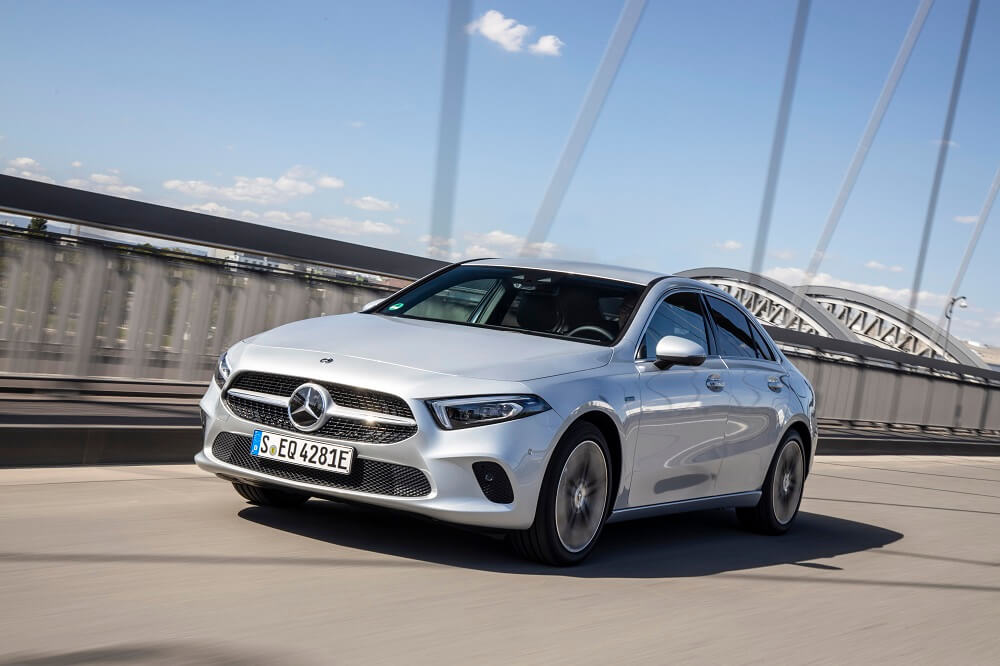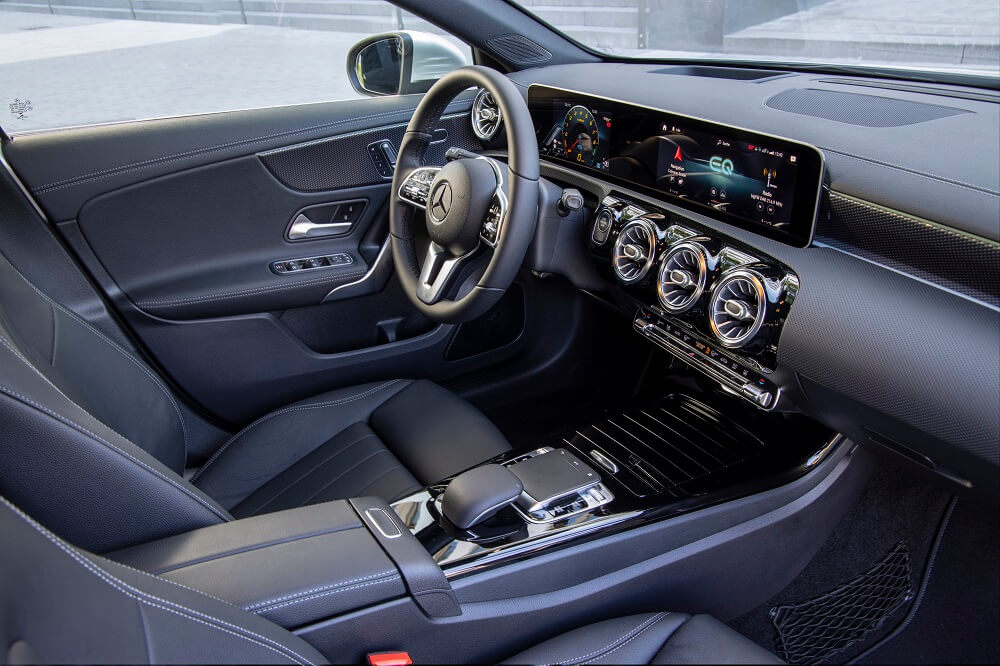Mercedes-Benz adds hybrid power to A-Class line-up
.jpg?h=666&iar=0&w=1000&rev=6dd0a22f44d9460caeec36a1d706ff41&hash=3630FDFB1EA97517C365BD33A16FFB97)
Mercedes-Benz has added a plug-in hybrid variant to its compact A-Class range, claiming the new A250 e hatch and sedan are capable of travelling up to 73km in all-electric mode.
A statement from the German prestige car maker said the release of the newest A-Class model, which falls under its EQ Power banner, is an important milestone on the company’s journey to zero-emissions driving.
The new model is also the first Mercedes-Benz plug-in hybrid (PHEV) passenger vehicle capable of handling rapid DC charging, which significantly reduces battery recharge times.
According to Mercedes-Benz the launch of the A250 e hatch and sedan creates a “best of both worlds” scenario, with the new model able to complete journeys around town of up to 73km in electric vehicle (EV) mode, using only its electric motor and on-board battery. Meanwhile, a 1.3-litre, four-cylinder internal combustion engine (ICE) is available and comes into its own to complete longer road trips.

The electric motor, with outputs of 75kW/300Nm, works in tandem with a 15.6 kWh battery. The petrol engine, meanwhile, produces 118kW/250 Nm, leading to a healthy combined output of 160kW/450Nm.
This compares favorably with the sporty turbocharged 2.0-litre four-cylinder powered A250 sedan and hatch, which boast outputs of 165kW/350Nm.
While their outputs might be similar, Mercedes-Benz claims the PHEV’s ability to switch seamlessly between EV and ICE drive modes delivers exceptional fuel economy in the order of 1.6L/100km, versus the 6.4L/100km average of the ICE-powered A250.
The enhanced fuel efficiency doesn’t come at the cost of performance, though, with the combined output of the electric and petrol-powered motors enabling 0-100km/h acceleration of 6.6 seconds for the hatch, and 6.7 seconds for the sedan. That’s more than two seconds quicker than the base A180 hatchback, and only a few tenths off the pace of the turbo petrol A250.
The A250 e puts its power to the front wheels via an 8G-DCT Hybrid eight-speed auto, joining the Mercedes-AMG A 45 S as only the second model in the A-Class range to receive an eight-speed transmission.
Other models boast a seven-speed transmission, with Mercedes-Benz claiming the extra cog improves the car’s fuel efficiency and all-electric range.
.jpg?rev=1dde16d8f02948b881765578639bf0ef&hash=465DCD05E2BBA881FA44B10717F0A76E)
The company says the A-Class was designed from the outset to accommodate the PHEV drivetrain, requiring only a small reduction in boot space in either the hatch (310 litres) or sedan (355 litres).
The water-cooled lithium-ion, high-voltage battery weighs 150kg but some of this is offset by a smaller 35-litre fuel tank and elimination of the separate 12-volt starter, since the engine is started by the electric motor.
Both the hatch and sedan are comprehensively equipped with standard features including 18-inch alloy wheels, MBUX infotainment system with voice control and full digital widescreen cockpit, navigation, faux leather upholstery, smartphone integration including wireless charging and LED headlights.
Standard safety equipment includes blind spot assist, active lane keep assist, traffic sign assist, nine airbags, PRE-SAFE accident anticipation system, and adaptive high beam assist.
A neat feature for hot climates like Queensland is a pre-entry climate control system that allows the cabin to be cooled before the vehicle is started, thanks to the A250 e using an electric refrigerant compressor.
.jpg?rev=89c9a168d71f4e6ebcac13cc2381b4b7&hash=2E1649C718DBDAE495C458FB00651901)
The feature can be activated via a smart phone app, which also includes remote vehicle status monitoring.
Priced at $63,400 (MRLP) for the hatch and $66,000 (MRLP) for the sedan (MRLP), the A250 e sits above the A250 4Matic sedan but below the A35 AMG Hatchback in the 12 model A-Class range.
On the charging front, the A250 e models come standard with a Type 2 plug enabling charging via standard AC household power at up to 3.7kW.
A faster charging home wall box is available as an option for $1250 (MRLP), delivering up to 7.4kW on single-phase power, or 22kW on three-phase power.
.jpg?rev=903e6a5de53f41fc87148ad08b8a27fd&hash=F7A9AFD8F357C9211275AB7E2B3AABD2)
Finally, customers can also purchase a DC Charging Package for $1490 (MRLP), which introduces fast DC charging at 24kW via a Type 2 CCS plug.
Using DC charging, it’s possible to charge from 10% capacity to 80% in 25 minutes, according to Mercedes-Benz. The DC charging package also upgrades the car’s AC charging system to 7.4kW.
Mercedes-Benz has previously said it is aiming for the complete de-carbonisation of its products and production processes by 2039. In addition to shifting to green manufacturing facilities and processes, the company is planning to exclusively offer either battery-electric, hydrogen-powered electric, and/or plug-in hybrid vehicles.
The German car maker currently breaks its powertrain strategy into three distinct streams: EQ Boost, EQ Power and EQ.

Models designed as EQ Boost feature a mild hybrid powertrain, where the main propulsion system is still a combustion engine but supported by an electric motor for better fuel economy.
EQ Power models like the new A250 e are plug-in hybrids, meaning they retain a combustion engine but feature a larger lithium-ion battery that can be recharged to allow a limited range of fully electric driving.
Finally, EQ covers the brand’s full battery electric models, including the EQC 400 released here last year.
The EQC 400 has an electric-only range of around 400km and is currently the only fully electric model in the company’s Australian line-up.
Mercedes-Benz has said that it plans to roll out six more fully electric EQ models before 2025.
Related topics
Things to note
The information in this article has been prepared for general information purposes only and is not intended as legal advice or specific advice to any particular person. Any advice contained in the document is general advice, not intended as legal advice or professional advice and does not take into account any person’s particular circumstances. Before acting on anything based on this advice you should consider its appropriateness to you, having regard to your objectives and needs.
Insurance Products (excluding Travel Insurance) are issued by RACQ Insurance Limited ABN 50 009 704 152 (RACQI) and arranged by its agent, RACQ Distribution Services Pty Ltd (RDS) ABN 35 116 361 650, AFSL 567130 and RDS' authorised representatives (including RACQ Operations Pty Ltd ABN 80 009 663 414, AR No. 234978 (RACQO). Conditions, limits and exclusions apply. RDS and RACQO are in the RACQ group of companies. One of the companies in the RACQ group of companies has a minority shareholding in RACQI.
RDS and RACQO have not taken your personal objectives, circumstances or needs into account when preparing advice regarding insurance products and you will need to consider whether the advice is appropriate for you. Read the Product Disclosure Statement (PDS) and any applicable Supplementary PDS before making a purchase decision on this product. You can also access our Target Market Determinations on this website. RDS receives a commission from RACQI for the policies it arranges. RACQO receives fees paid for services it provides to RDS. Further details about remuneration are available on request prior to purchasing.
Banking and loan products issued by Members Banking Group Limited ABN 83 087 651 054 AFSL/Australian credit licence 241195 trading as RACQ Bank. Terms, conditions, fees, charges and lending policies apply. This is general advice only and may not be right for you. This information does not take your personal objectives, circumstances or needs into account. Read the disclosure documents for your selected product or service, including the Financial Services Guide and the Terms and Conditions, and consider if appropriate for you before deciding.
Except for RACQ Bank, any RACQ entity referred to on this page is not an authorised deposit-taking institution for the purposes of the Banking Act 1959 (Cth). That entity’s obligations do not represent deposits or other liabilities of RACQ Bank. RACQ Bank does not guarantee or otherwise provide assurance in respect of the obligations of that entity, unless noted otherwise.
RACQ Bank subscribes to the Customer Owned Banking Code of Practice which establishes higher standards than the law requires. The Code reflects modern consumer expectations and developments in approaches to issues such as consumer vulnerability, guarantors, and supporting customers through financial hardship. Please read our Customer Owned Banking Code of Practice page for more information.
RACQ Operations Pty Ltd (ABN 80 009 663 414 AR 000234978) and Members Travel Group Pty Ltd (ABN 45 144 538 803 AR 000432492) are acting as an Authorised Representative of the issuer of the insurance, Tokio Marine & Nichido Fire Insurance Co., Ltd. (ABN 80 000 438 291 AFSL 246 548). Any advice set out above is general in nature only, and does not take into account your objectives, financial situation or needs. Before purchasing any travel products, please consider the RACQ Travel Insurance Product Disclosure Statement (PDS) and the Target Market Determinations (TMDs) that apply to these products. Whilst the PDS outlines the Terms and Conditions of these products, the TMDs outline the intended class of customers that comprise the target market for these travel products. This will allow you to consider which products best suit your objectives, financial situation and needs and consider the products appropriateness to your personal circumstances. TMDs also outline matters involving the distribution and the review of these products. The PDS, Supplementary PDS and TMDs for each travel product can be found here.

